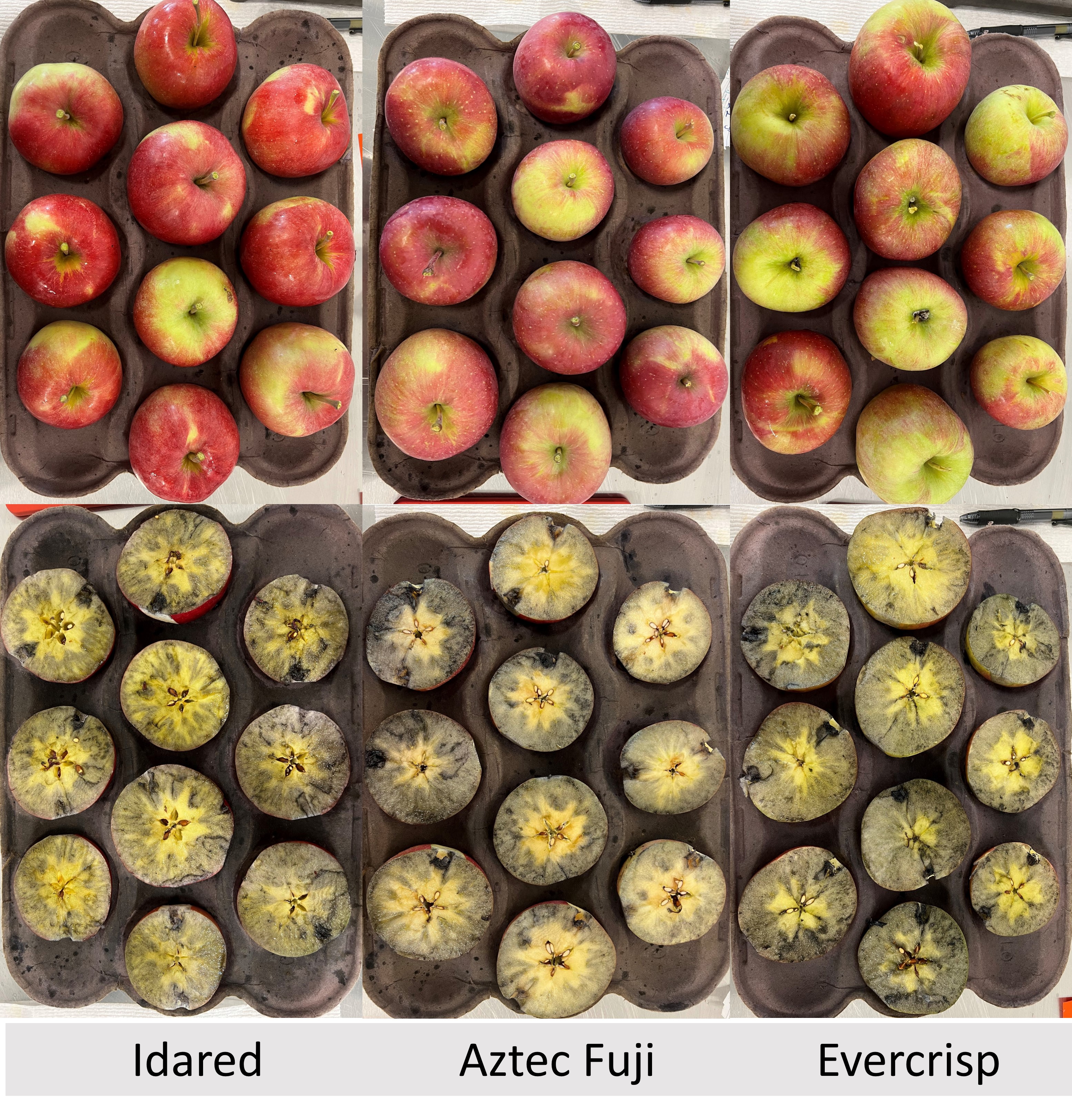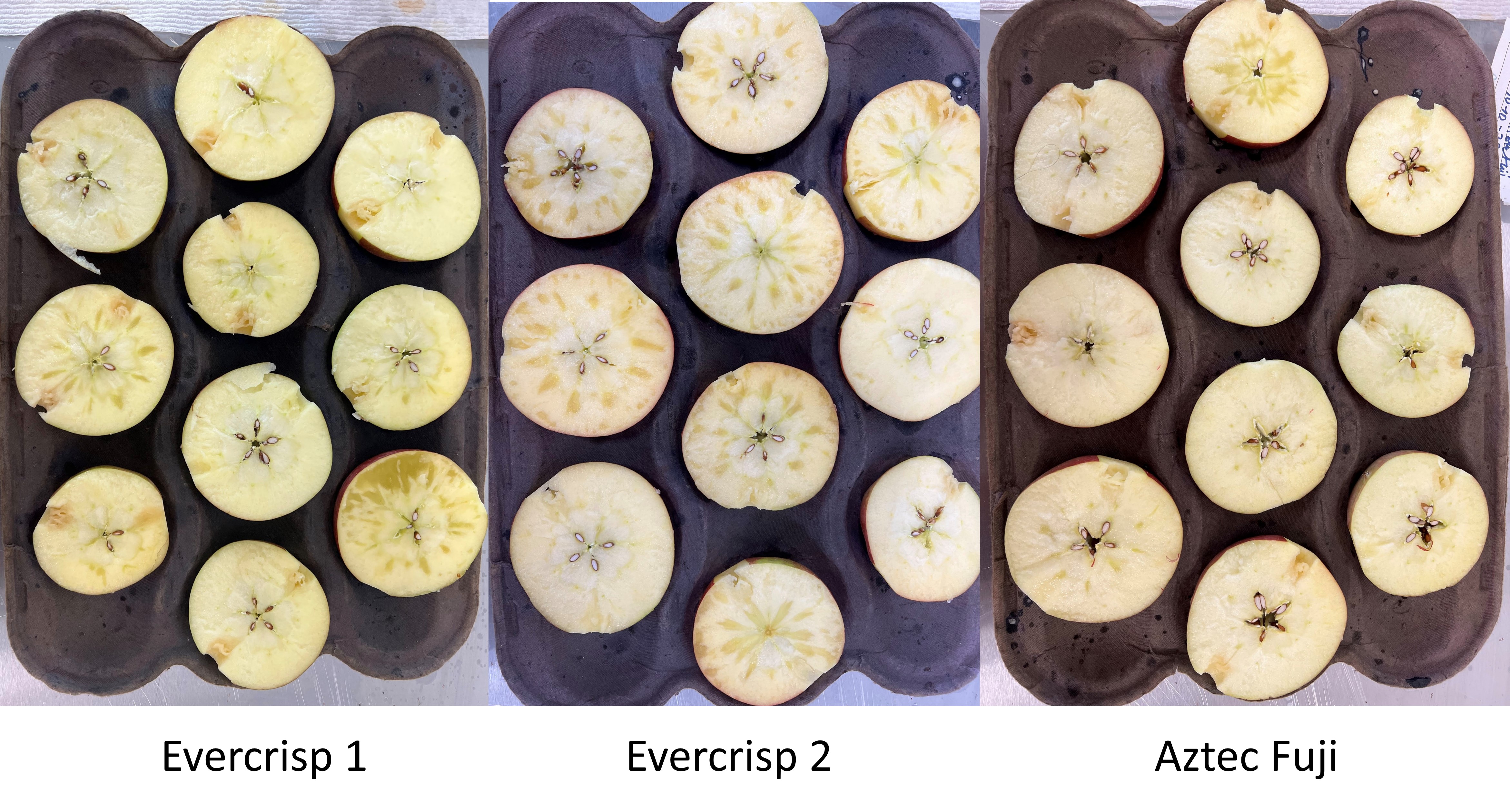West central Michigan apple maturity report – October 12, 2022
Varieties such as Red Delicious, Golden Delicious and Mutsu are being harvested this week. Idared are moving closer to maturity. Evercrisp are still immature.

Apple maturity testing will occur weekly for the west central region beginning now through the end of apple harvest. Reports will be sent out every week, following the Wednesday morning Michigan State University Extension fruit team apple maturity calls.
In the west central region, growers are harvesting varieties such as Red and Golden Delicious, Northern spy, and Mutsu. Idared and Aztec Fuji are showing signs of maturity. Evercrisp and Pink lady are still immature. Apple harvest is moving steadily, and fruit continue to size more than expected. Red color development has been excellent, and sugar levels are increasing with cooler temperatures and sunny days.
Weather over the past week has generally been cool. Conditions had been dry, but the past 24 hours has brought rain across the region. Rain is forecasted over the next few days, and some areas may get up to 2 inches of rain by the end of the week. There have also been some frosty mornings over the past few days. Daytime temperatures have ranged in the 50s Fahrenheit to 60s F, and nighttime temperatures have ranged from the 30s F to 50s F with locations in Mason County reaching temperatures below freezing. As of Oct. 11, the Enviroweather station for Hart has reported an accumulation of 3757 DD42 and 2437 DD50. Cool weather will continue, and we may see snow flurries toward the end of the week.
As fruit harvest continues, growers should consider applying preharvest fungicides to minimize storage rots. As a reminder, with regular rain events, growers should maintain fungicide coverage to minimize late season rots, particularly for fruit that will be in long-term storage. Over 2 inches of rainfall can wash off fungicide residues on fruit. Excessive rain may also have an impact on fruit by temporarily diluting flavor and brix (sugars).

How to read maturity tables
Each week, an apple maturity report will be provided and will include average values for several apple samples for varieties nearing maturity. Maximum and minimum values are included in tables below for the highest and lowest individual fruits evaluated for each, to give a full spectrum of maturity. All samples included in the reports have been untreated with ReTain or Harvista, unless otherwise noted. Samples were collected from two to three locations across Oceana County.
For more information about apple maturity testing, review these resources compiled by Anna Wallis and Amy Irish Brown, MSU Extension.
- Predicted apple harvest dates for 2022 from MSU
- More information on harvest management tools and timings can be found in this article.
- Guidelines from MSU to check for apple maturity in your own orchard, including specific pressure and starch recommendations by variety.
- Predicting apple maturity and starch chart from Cornell University
- Starch chart for Honeycrisp Apples developed by Washington State University.
Maturity information for the west central region
Idared
Fruit were sampled from three locations on Oct. 10 in Oceana County. Red color development is improving and is at 76.3% on average. Background color is improving at a rating of 2.9. Fruit firmness was similar to last week at 15.5 lbs. On average, starch clearing increased from last week from an average of 2.2 to 3.7 this week. Sugars levels continue to be good according to the Brix table below.
|
Collection Date |
Fruit Weight (g) |
Red Color (%) |
Background color (5-1) |
Firmness (lbs) |
Starch (1-8) |
Soluble Solids (°Brix) |
|
Sept 26 |
211 (230-201) |
67.5 (90-50) |
3.1 (5-2) |
17.0 (18.9-13.0 |
1.3 (2-1) |
12.1 (13.2-11.5) |
|
Oct 3 |
194 (203-180) |
74.2 (90-60) |
3.1 (4-2) |
15.4 (18.1-13.3) |
2.2 (4-1) |
12.3 (12.4-12) |
|
Oct 10 |
210 (213-207) |
76.3 (98-50) |
2.9 (4-2) |
15.5 (18.1-13.1) |
3. 7 (6-2) |
12.5 (12.6-12.4) |
Aztec Fuji
Fruit were sampled from three locations on Oct. 10 in Oceana County. Background color is transitioning from light green to more yellow. Red color development was 80% on average, but this varied by location. Fruit firmness also varied from site to site with an average of 16.3. Starch clearing is 3.8, and sugars levels are excellent at 13.6 according to the Brix table below. Some watercore was present at all locations sampled.
|
Collection Date |
Fruit Weight (g) |
Red Color (%) |
Background color (5-1) |
Firmness (lbs) |
Starch (1-8) |
Soluble Solids (°Brix) |
|
Oct 10 |
219 (245-189) |
80.8 (98-60) |
2.7 (4-1) |
16.3 (20.6-13.1) |
3.8 (6-2) |
13.6 (13.9-13.4) |
Evercrisp
Fruit were sampled from three locations on Oct. 10 in Oceana County. Red color is still developing with an average of 68.8% red color. Fruit are generally very firm with an average of 21.5. Starch clearing is moderate. Penn State University recommends using a starch index of 4-6 for long-term storage and 6-7 for direct sales markets. Sugar levels are excellent for this variety. Similar to its Fuji parentage, watercore was present at all locations samples.
|
Collection Date |
Fruit Weight (g) |
Red Color (%) |
Background color (5-1) |
Firmness (lbs) |
Starch (1-8) |
Soluble Solids (°Brix) |
|
Oct 10 |
261 (269-255) |
68.8 (95-50) |
3. 7 (5-2) |
21.5 (27.4-16.6) |
3.1 (6-2) |
15.8 (18.3-14.4) |

Pink lady
Fruit were sampled from two locations on Oct. 10 in Oceana County. Fruit were smaller in size than other varieties. A vibrant pink blush was present on fruit, and background color is pale green at an average of 3.2. Fruit are very firm with an average pressure of 18.8 lbs. On average, starch clearing is 2.4, and sugars levels are excellent. This variety is still immature.
|
Collection Date |
Fruit Weight (g) |
Red Color (%) |
Background color (5-1) |
Firmness (lbs) |
Starch (1-8) |
Soluble Solids (°Brix) |
|
Oct 10 |
170 (175-165) |
61 (75-45) |
3.2 (4-2) |
18.8 (23.7-15.1) |
2.4 (6-1) |
14.1 (14.9-13.3) |
Apple maturity sampling parameters
- Ethylene (% fruits with internal ethylene over 0.2 ppm) = indicates when ethylene begins to influence fruit ripening and it cannot be held back easily after this is reached.
- Color % = the visual percentage of red color from 0 to 100; range is of all fruits tested. Indicates surface area covered in red and intensity of red color.
- Background color: 5 = Green, 1 = Yellow; range is of all fruits tested.
- Firmness in pounds pressure = measured with a Güss Fruit Texture Analyzer; range is of all fruits tested.
- Starch: 1 = all starch, 8 = No starch; range is of all fruits tested. Using Cornell Starch Iodine Index Chart.
- Starch For Honeycrisp: will typically be rated using the standard Cornell SPI scale (1-8). However, a separate starch chart for Honeycrisp Apples developed by Washington State University (scale 1-6) also exists.
- Brix = % sugar measured with Atago PAL-1 Pocket Refractometer
Looking for more? View Michigan State University Extension’s Apple Maturity page for regional reports throughout the state and additional resources.
|
Suggested firmness and starch index levels for long-term and shorter-term controlled atmosphere (CA) storage by variety. |
|||||
|
Variety |
Firmness (pounds)* |
Starch Index* |
|||
|
Short CA |
Mid-CA |
Long CA |
Mature |
Over mature |
|
|
McIntosh |
14 |
15 |
16 |
5 |
7 |
|
Gala |
16 |
17 |
18 |
3 |
6 |
|
Honeycrisp |
15 |
16 |
17 |
3.5 |
6 |
|
Empire |
14 |
15 |
16 |
3.5 |
6 |
|
Early Fuji |
16 |
17 |
18 |
3 |
7 |
|
Jonagold |
15 |
16 |
17 |
3.5 |
5.5 |
|
Jonathan |
14 |
15 |
16 |
3.5 |
5.5 |
|
Golden Delicious |
15 |
16 |
17 |
3 |
6.5 |
|
Red Delicious |
16 |
17 |
18 |
2.5 |
6 |
|
Idared |
14 |
15 |
16 |
3.5 |
6 |
|
Fuji |
16 |
17 |
18 |
3 |
7 |
|
Rome |
15 |
16 |
18 |
3 |
5.5 |
|
Brix Guide |
Low |
Fair |
Good |
Excellent |
|
All varieties |
Less than 11 |
11 |
12 |
13 |
|
Honeycrisp |
Less than 12 |
12 |
12 |
Greater than 14 |
|
Brix Guide |
Low |
Fair |
Good |
Excellent |
|
All varieties |
Less than 11 |
11 |
12 |
13 |
|
Honeycrisp |
Less than 12 |
12 |
12 |
Greater than 14 |



 Print
Print Email
Email
